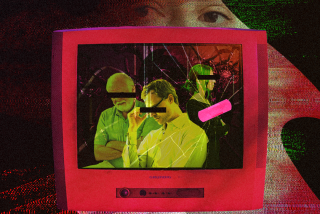Time for an Adult Conversation About R’s Failure
- Share via
The one true thing that can be said about the current fracas involving Hollywood sex and violence, its effect on society and its marketing to young people is that neither side in the dispute has exactly covered itself with glory. In an atmosphere replete with finger-pointing and recrimination, it’s not surprising that the single sanest suggestion yet made has been overlooked and underappreciated.
On the one hand, hyperventilating politicians, reaching levels of high outrage at what the studios are doing to America’s moral fiber, call to mind Claude Raines’ disingenuous Captain Renault in “Casablanca” saying he was shocked, shocked to find that gambling, yes gambling, was taking place at Rick’s. What universe do these people inhabit? How out of touch can they be with the direction American popular culture, up to and including omnipresent TV commercials and even billboards, has been taking for years, that they are discovering this trend just in time for a national election?
Not that Hollywood’s defenders are looking much better. Like pro-weapons zealots who feel that stopping private citizens from buying automatic armaments by the carload is an open invitation to dictatorship and prison camps, there are those who feel that if “The Cell” and its scenes of horrific torture can’t be sold to an acquiescent citizenry, the republic would be in peril and books would be burned in the streets the very next morning.
The whole question of what should and should not be shown to young people is one that can appear either simple or complex, depending on how you look at it. Yes, it’s true that each generation always feels the next one is going too far, and that Elvis, ragtime and even Jimmy Cagney’s gangsters were condemned in their day. Yes, it’s not been proved to all scientists’ satisfaction that violent images do lasting damage. Yes, increased parental involvement in what their children consume would help more than anything.
But the truth is that nothing is really gained by fleeing from reality and taking arguments to extremes. You don’t have to prove that violent films directly cause mayhem to feel that constant vivid and explicit images of supercharged hostility fed to children in particular and society in general do a lot more harm than good. In the words of one newspaper letter writer, they “set a tone and a mood . . . send the message that in America, violence is the answer to almost any problem.”
Also, it’s important to recognize several factors that do not correlate with adult panic states of the past. For one thing, special effects technology has advanced to such a point that the most stomach-turning violence can be graphically rendered on screen with almost clinical verisimilitude. For another, TV and the computer have made popular culture more pervasive, more difficult for anyone to resist, than at any previous time. Finally, because of the amount of money at their disposal, young people are not just absorbing things intended for adults, they are setting the agenda for an entire culture. If, in previous eras, adults worried that things they liked would corrupt children, now the problem is that material adults don’t even care for is being supported to a great extent by a youthful audience that seems impervious to adult influence.
In this kind of world, parents need all the help they can get in knowing and understanding exactly what both they and their children will be exposed to should they venture forth to the local megaplex. Given that parents can’t always take the time to research specific films, what’s needed is a system that can be trusted to accurately characterize what happens on screen.
Hark, a sonorous voice says at this point. It’s the silver-tongued orator of the Potomac, Jack Valenti, head of the Motion Picture Assn. of America, who wants it known that we’ve got such a rating system, best one in the world; it’s worked like a clock for 32 years. That logic has long worked for Valenti, but at the recent congressional hearings, Sen. John McCain was unimpressed. “It doesn’t matter if the current ratings system is 32 years old or 300 years old,” he said. “We still hear from parents and families . . . that there is a lack of understanding.”
The truth is, even if the studios follow through on what appears to be a promise to give more prominence to the reasons for specific ratings, no one who has taken the trouble to look closely respects the system anymore. And when Valenti defends it by quoting statistics that claim 81% of parents with children younger than 13 find the ratings beneficial, he is inadvertently pointing up its biggest weakness: the R rating.
Put simply, the R rating (children under 17 not admitted without an adult) has become a joke, a grab bag, a one-size-fits-all fiasco that couldn’t be of less help in the real world. Part of the reason is that the NC-17 rating, intended for truly adult material, has become taboo: Many video outlets won’t carry NC-17s, and some theater chains are apparently forbidden by their leases to show them. So everyone has to be made to fit into R’s Procrustean bed, which is how couldn’t-be-more-different films such as “Election” and “Almost Famous” on the one hand and “8MM” and “The Cell” on the other, find themselves with the same rating.
There’s R-Rated, and Then There’s R-Rated
Since this result is impossible to defend on its face--in fact, more than two-thirds of films currently released receive an R rating--the system’s partisans resort to sophistry. “Not all R-rated films are alike,” Valenti told Congress. “Some R-rated movies are ‘hard’ Rs, that is, at the top of the R-scale, and others are ‘soft’ R’s, at the bottom of the scale.” This is all very nice, but nobody outside the movie business has any idea that that distinction even exists, let alone knows what it means. If the ratings are supposed to help non-show biz parents decide what’s appropriate to be seen, shouldn’t that difference be explicit and not one you have to subscribe to Daily Variety to understand?
This is, in effect, what the Directors Guild of America, through its Task Force on Violence and Social Responsibility, proposed a few weeks ago. The DGA broke ranks with the MPAA and called for a revision of the ratings system, calling the NC-17 “an abject failure,” which is what it is, and saying in public what everyone in Hollywood has long known: “Many films that should not be seen by minors are re-cut so that they receive a ‘hard’ R rating. This has the effect of not only compromising filmmakers’ visions, but also greatly increases the likelihood that adult-oriented movies are seen by the very groups for which they are not intended.”
This is very much a sane, real-world proposal because it accepts that unless the values of the marketplace change in the foreseeable future (or unless the envelope gets pushed so far by greed-heads that either self-generated or externally imposed censorship becomes a reality), the studios will continue to make nauseatingly violent films no matter how much certain critics (no names, please) wish to God they would stop. The question then becomes: How do you rate them in a way that is meaningful and not an embarrassing sham?
It wouldn’t be all that difficult. You could formalize the two different kinds of Rs, or invent a new letter; A for adult has been suggested. Even shrewder is a suggestion going around town to create a new rating that would be called PG-17, where films like “Almost Famous” would fit. That name would have the benefit of accentuating the positive side of the films that got a softer rating, letting parents know that they are more likely to approve them than the hard stuff that would stay in R.
Whichever approach wins out, the situation puts one in mind of a baseball slogan of the 1950s. When a certain team became too powerful for anyone’s good, the cry went out around the league to “break up the Yankees.” Now that a certain rating has become so powerful it threatens to emasculate the entire MPAA rating system, it’s time--heck, it’s way past time--to break up the R.
More to Read
The biggest entertainment stories
Get our big stories about Hollywood, film, television, music, arts, culture and more right in your inbox as soon as they publish.
You may occasionally receive promotional content from the Los Angeles Times.











